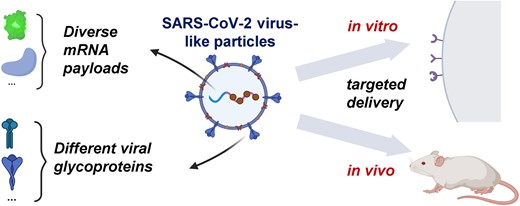Published: 2025-03-24
Journal Link: Nucleic Acids Research, Volume 53
Petar Pajic, Qi Yang, Bruce A Davidson, Xuyang Chen, Omer Gokcumen, Min Gao, Sriram Neelamegham
Abstract
Severe acute respiratory syndrome coronavirus 2 (SARS-CoV-2) virus-like particles (VLPs) are ∼100-nm-sized bioinspired mimetics of the authentic virus. We undertook molecular engineering to optimize the VLP platform for messenger RNA (mRNA) delivery. Cloning the nucleocapsid protein upstream of M-IRES-E resulted in a three-plasmid (3P) VLP system that displayed ∼7-fold higher viral entry efficiency compared with VLPs formed by co-transfection with four plasmids. More than 90% of human ACE2-expressing cells could be transduced using these 3P VLPs. Viral tropism could be programmed by switching glycoproteins from other viral strains, including other betacoronaviruses and the vesicular stomatitis virus G protein. An infectious two-plasmid VLP system was also advanced where one vector carried the viral surface glycoprotein and the second carried the remaining SARS-CoV-2 structural proteins and reporter gene. SARS-CoV-2 VLPs could be engineered to carry up to four transgenes, including functional Cas9 mRNA for genome editing. Gene editing of specific target cell types was feasible by modifying VLP tropism. Successful mRNA delivery to mouse lungs suggests that the SARS-CoV-2 VLPs can overcome natural biological barriers to enable pulmonary gene delivery. Overall, the study describes the advancement of the SARS-CoV-2 VLP platform for robust mRNA delivery both in vitro and in vivo.
